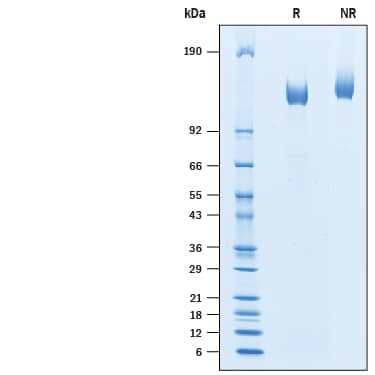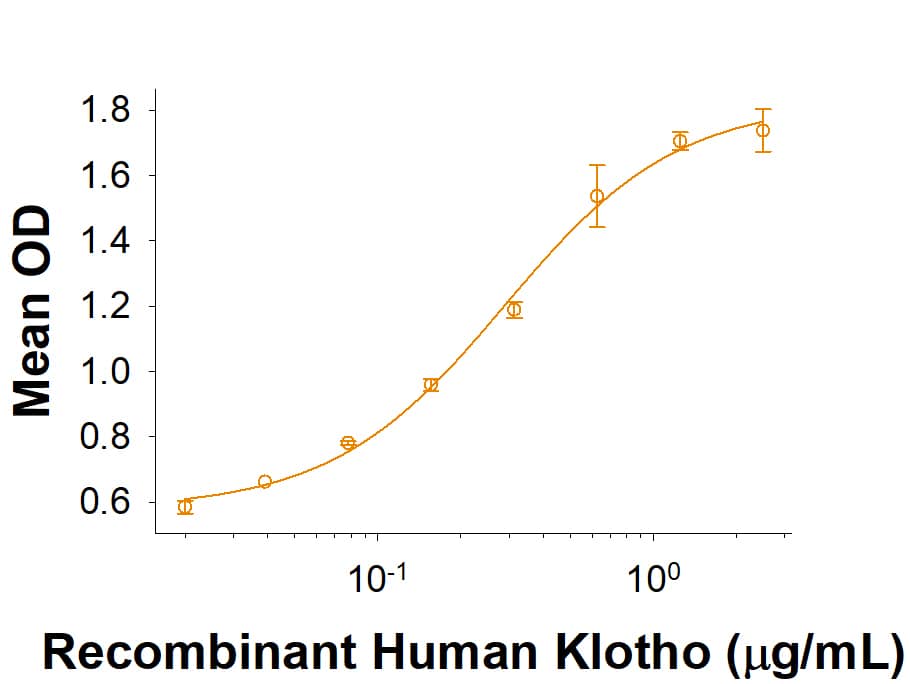Recombinant Human Klotho His-tag Protein, CF
R&D Systems, part of Bio-Techne | Catalog # 10308-KL
Mucin Stalk Chimera

Key Product Details
Source
CHO
Conjugate
Unconjugated
Applications
Bioactivity
Product Specifications
Source
Chinese Hamster Ovary cell line, CHO-derived human Klotho protein
| Human Klotho (Glu34-His549) Accession # Q9UEF7 |
Human Fractalkine Mucin-like Stalk (Phe103-Thr338) Accession # P78423 |
6-His tag |
| N-terminus | C-terminus |
Purity
>95%, by SDS-PAGE visualized with Silver Staining and quantitative densitometry by Coomassie® Blue Staining.
Endotoxin Level
<0.10 EU per 1 μg of the protein by the LAL method.
N-terminal Sequence Analysis
Glu34
Predicted Molecular Mass
84 kDa
SDS-PAGE
110-140 kDa, under reducing conditions
Activity
Measured by its binding ability in a functional ELISA.
When Recombinant Human FGF-23 (Catalog # 2604-FG) is immobilized at 5 µg/mL (100 µL/well), Recombinant Human Klotho Mucin Stalk Chimera His-tag (Catalog # 10308-KL) binds with an ED50 of 0.2-1.8 μg/mL.
When Recombinant Human FGF-23 (Catalog # 2604-FG) is immobilized at 5 µg/mL (100 µL/well), Recombinant Human Klotho Mucin Stalk Chimera His-tag (Catalog # 10308-KL) binds with an ED50 of 0.2-1.8 μg/mL.
Scientific Data Images for Recombinant Human Klotho His-tag Protein, CF
Recombinant Human Klotho His-tag Protein Binding Activity
When Recombinant Human FGF-23 (Catalog # 2604-FG) is immobilized at 5 µg/mL, 100 µL/well, Recombinant Human Klotho Mucin Stalk Chimera His-tag (Catalog # 10308-KL) binds with an ED50 of 0.2-1.8 µg/mL.Recombinant Human Klotho His-tag Protein SDS-PAGE
2 μg/lane of Recombinant Human Klotho Mucin Stalk Chimera His-tag (Catalog # 10308-KL) was resolved with SDS-PAGE under reducing (R) and non-reducing (NR) conditions and visualized by Coomassie® Blue staining, showing bands at 110-140 kDa.Formulation, Preparation and Storage
10308-KL
| Formulation | Lyophilized from a 0.2 μm filtered solution in PBS with Trehalose. |
| Reconstitution | Reconstitute at 500 μg/mL in PBS. |
| Shipping | The product is shipped at ambient temperature. Upon receipt, store it immediately at the temperature recommended below. |
| Stability & Storage | Use a manual defrost freezer and avoid repeated freeze-thaw cycles.
|
Background: Klotho
References
- Nabeshima, Y. (2006) Sci. Aging Knowl. Environ. 8:pe11.
- Kuro-o, M. et al. (1997) Nature 390:45.
- Shiraki-Iida, T. et al. (1998) FEBS Lett. 424:6.
- Imura, A. et al. (2004) FEBS Lett. 565:143.
- Yuechi, X. et al. (2015) Endocr Rev. 36:174.
- Kurosu, H. et al. (2006) J. Biol. Chem. 281:6120.
- Tsujikawa, H. et al. (2003) Mol. Endocrinol. 17:2393.
- Hu, M. et al. (2012) Adv Exp Med Biol. 728:126.
- Wu, X. et al. (2007) J. Biol. Chem. 282:29069.
- Chang, Q. et al. (2005) Science 310:490.
Alternate Names
KL
Gene Symbol
KL
Additional Klotho Products
Product Documents for Recombinant Human Klotho His-tag Protein, CF
Product Specific Notices for Recombinant Human Klotho His-tag Protein, CF
For research use only
